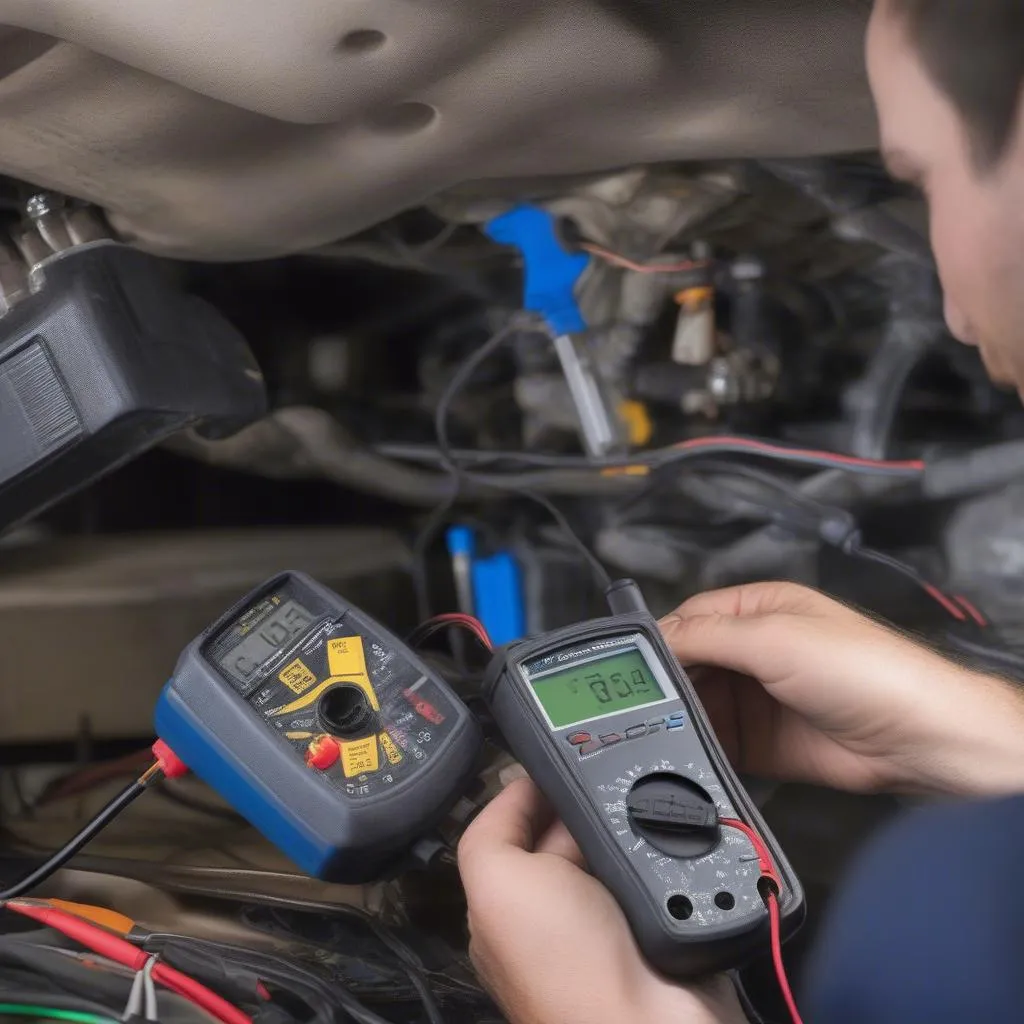Have you ever experienced a “Check Engine” light illuminating on your dashboard? This is a common experience for many Ford owners, and sometimes it can be a little frightening. Imagine this: You’re driving down the highway on a beautiful day, enjoying the drive when suddenly, the “Check Engine” light pops on, and you’re left wondering what’s going on. This is exactly what happened to a friend of mine who owns a 2013 Ford Focus. After a quick trip to his local mechanic, he was told it was a faulty oxygen sensor and required replacement. This incident is just one example of how a “Check Engine” light can signal various issues, one of which could be the infamous “P0153” OBD trouble code.
What is Ford Obd Trouble Code P0153?
The P0153 OBD trouble code specifically indicates a “O2 Sensor Circuit Slow Response (Bank 2 Sensor 1)”. This can be confusing if you’re not a car expert.
Let’s break it down for you:
- OBD stands for On-Board Diagnostics. This is the system within your car that monitors engine performance and sends information to the control module (ECU).
- O2 Sensor is a critical component of your exhaust system. It measures the amount of oxygen in the exhaust gases and sends this information to the ECU.
- Bank 2 refers to the side of the engine that doesn’t contain cylinder #1.
- Sensor 1 indicates that the issue is with the oxygen sensor closest to the engine.
- Slow Response implies that the oxygen sensor is not responding quickly enough to changes in the oxygen levels in the exhaust.
Essentially, the P0153 OBD trouble code means the ECU has detected that your oxygen sensor is not performing as it should. This can lead to a variety of problems, including poor fuel economy, increased emissions, and even a rough idle.
Understanding the Implications of P0153
From a Mechanic’s Perspective:
A faulty oxygen sensor can cause a ripple effect across your car’s engine system, potentially affecting other components, like the catalytic converter. This is why it’s important to address the P0153 code promptly.
From a Technical Perspective:
The oxygen sensor acts as a feedback mechanism for the engine. It helps the ECU adjust the air-fuel mixture to optimize combustion and minimize emissions. When the oxygen sensor is slow to respond, the ECU may not be able to fine-tune the air-fuel mixture correctly, leading to inefficient combustion and increased emissions.
From an Economic Perspective:
Ignoring the P0153 code can lead to costly repairs down the line. An oxygen sensor replacement is generally a relatively inexpensive fix, but if left unchecked, it can damage other components, leading to more expensive repairs.
Diagnosing the P0153 Trouble Code
Diagnosing the P0153 code requires a thorough inspection of the O2 sensor circuit, including:
- Visual Inspection: Checking for any visible damage to the wiring, connector, or the sensor itself.
- Voltage Test: Using a multimeter to measure the voltage output of the oxygen sensor.
- Resistance Test: Testing the resistance of the oxygen sensor wiring and connector.
- Fuel Trim Values: Examining the fuel trim values in the ECU data stream to determine if there is an issue with the fuel-air mixture.
You can visualize this process in action with this illustration:  Oxygen Sensor Inspection
Oxygen Sensor Inspection
Common Causes of P0153
Faulty Oxygen Sensor: This is the most common cause of P0153. The oxygen sensor can become contaminated, corroded, or simply wear out over time.
Damaged Wiring: Damaged wiring to the oxygen sensor can also cause the slow response code. This can be caused by physical damage, corrosion, or even a loose connection.
ECU Issue: In rare cases, the P0153 code could be caused by a fault in the ECU itself.
Troubleshooting P0153
- Check the O2 sensor for damage: If the sensor is physically damaged, it will need to be replaced.
- Inspect the wiring for any damage or corrosion: Repair any damage to the wiring, or replace the wiring altogether if it is severely damaged.
- Check the connector for a loose connection: If the connector is loose, tighten it or replace it if necessary.
- Test the O2 sensor with a multimeter: Use a multimeter to test the sensor’s voltage output and resistance. If the sensor is faulty, it will need to be replaced.
- Check the fuel trim values in the ECU data stream: If the fuel trim values are excessively high or low, this could indicate an issue with the fuel-air mixture.
Important: If you’re not comfortable performing these tests yourself, it’s best to take your car to a qualified mechanic.
Solutions for P0153
- Replace the Oxygen Sensor: This is the most common solution and can be done by a qualified mechanic.
- Repair Damaged Wiring: If the wiring is damaged, it needs to be repaired or replaced.
- Tighten Loose Connectors: A loose connection can cause the slow response issue.
- Consider ECU Issues: If the above solutions don’t resolve the P0153, it’s possible that the ECU may need to be repaired or replaced.
Remember: A faulty oxygen sensor can negatively impact your car’s performance and fuel efficiency. Addressing the P0153 code promptly is crucial for maintaining your vehicle’s health and ensuring optimal performance.
Here’s an example of a mechanic replacing a faulty oxygen sensor:  Oxygen Sensor Replacement
Oxygen Sensor Replacement
Frequently Asked Questions
- Can I drive my car with a P0153 code?
- It’s generally okay to drive with a P0153 code for a short period, but it’s not recommended to drive for extended periods without addressing the issue.
- What are the symptoms of a faulty oxygen sensor?
- Some symptoms of a faulty oxygen sensor include a check engine light, poor fuel economy, increased emissions, and a rough idle.
- How much does it cost to replace an oxygen sensor?
- The cost of replacing an oxygen sensor can vary depending on the make and model of your car, but it is typically a relatively inexpensive repair.
Related Articles
- Ford OBD Trouble Codes Explained
- How to Reset the Check Engine Light
- Understanding Automotive Sensors
Need help diagnosing or fixing your Ford Obd Trouble Code P0153? Don’t hesitate to contact us. We have a team of experts available 24/7 to assist you. Contact us via WhatsApp at +84767531508.